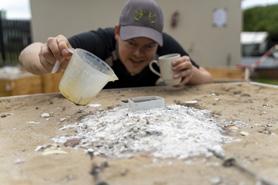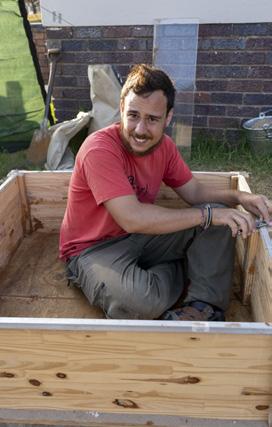
3 minute read
Experimental field season
Turid Hillestad Nel adjusting the fire. Ole F. Unhammer and Jovana Milic capturing data at the total station.



RESEARCH WITH A SMOKY FLAVOUR
A team of six early career researchers from SapienCE spent three weeks in Jongensfontein, South Africa, conducting, recording and cleaning up fire experiments. We came back with clothes, cameras and samples that reeked of fires and boxes full of samples. Here is a report from research with a smoky flavour.
JONGENSFONTEIN AND THE CAMP SITE
Jongensfontein is a sleepy coastal village in the Western Cape, approximately 16 km from Still Bay. The Jongensfontein Camping, Caravan and Self-Catering park is situated by the local beach and contains chalets with a sleeping room, bathrooms and small kitchens. Three of these became a home away from home during the experimental archaeology season in February and March 2020. We were able to set up a sample sorting station and a field computer laboratory in the chalets, but most of the activities took place outside.
The fire experiments were outdoor, realistic experiments, but we needed to control the conditions of the experiments as much as possible. Ole F. Unhammer had designed four standardized boxes to ensure similar set-ups for all fires. Each box was assembled and filled with a base layer of industrial sand and a top layer of local dune sand. Thermoprobes connected to thermometers were inserted within these sands and at the surface, so that the temperatures of the fires could be recorded.
THE TEAM AND EXPERIMENTS
Silje Evjenth Bentsen initiated and managed the experimental season, but all participants were deeply involved in the planning process and in making everything run smoothly. All team members of the field season had prepared a project with a set of questions to be explored during the experiments. Ole F. Unhammer worked to determine the best method for recording and documenting the fire experiments, while the effects of heat on micromammal bones, owl pellets, ostrich eggshell, seashell and ochre were examined by Turid Hillestad Nel, Silje Evjenth Bentsen, Jovana Milic and Elizabeth Velliky. Magnus Haaland’s primary experimental interest was the effects of heating upon the sediments themselves. In addition to the early career researchers, the experimental team also included senior researcher Carin Andersson-Dahl, who supervised Jovana Milic in between helping out on the site. Senior researcher Simon Armitage also spent some days with us, supervising Ole F. Unhammer, and collecting samples to determine the effects of heating on the properties of luminescence dating samples.
Each experiment consisted of two boxes, each containing one fire. The two fires were lit at the same time and burnt the same type and mass of wood. The duration of the experiments lasted from a few hours to 12 days, during which the fires were fed continuously. This meant that we had to work in shifts to monitor the fires 24 hours a day. In addition, we had to document and excavate the boxes after each experiment had finished. Our three weeks in Jongensfontein were thus filled with action both night and day!
THE RESULTS
We were able to collect enough data on temperatures, methods and heating effects to keep us busy for a long time! The samples from the season were shipped to Bergen, where analyses are ongoing. We are thus still waiting for many of the scientific results. Nevertheless, one very positive outcome of the season was that we coordinated efforts and results and organized a session at the experimental archaeology virtual conference (EXARC World Tour). The team will present preliminary results and experiences with a wide audience in March 2021, and updates will surely follow in our next report.
And in case you were wondering, were these experiments smelly? The answer is: We all smelled like we were heavy smokers, as did our equipment. The smell of freshly unpacked samples in Norway is powerfully evocative of a productive and enjoyable three weeks of experimental archaeology in Jongensfontein 2020.








